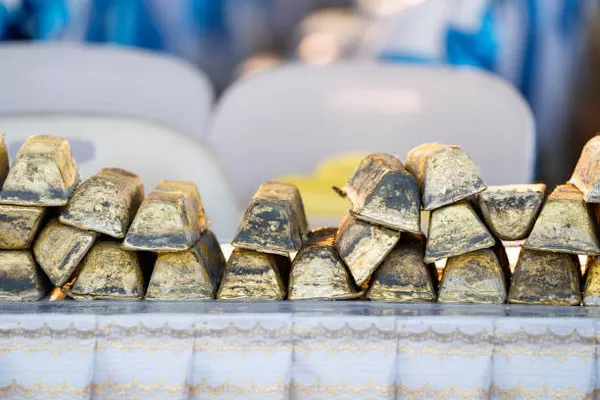Gold has long been a symbol of wealth and prosperity, with a rich history dating back thousands of years. Today, it remains a coveted asset for investors and individuals alike. However, understanding how gold buyers determine its value can be a complex and multifaceted process. In this article, we will delve into the intricacies of how gold buyers evaluate the worth of this precious metal.
The Basics of Gold Valuation
Before we delve into the specifics of how gold is valued, it’s crucial to grasp the fundamental concepts that underpin this process. Gold, like any other commodity, derives its value from a combination of supply and demand dynamics, as well as various economic and geopolitical factors. Here are the key factors that contribute to gold’s value:
Spot Price: The most basic factor in determining the value of gold is its spot price, which represents the current market price for a troy ounce of gold. This price fluctuates constantly throughout the trading day based on global supply and demand dynamics.
Purity: The purity of gold is measured in karats, with 24-karat gold being 99.9% pure. The higher the purity, the more valuable the gold. Buyers pay a premium for purer gold.
Weight: The weight of the gold item, typically measured in troy ounces or grams, directly affects its value. More weight means more gold content and, therefore, a higher value.
Market Demand: Gold’s value is influenced by demand from various sectors, including jewelry, investment, and industrial uses. Economic conditions and geopolitical events can drive shifts in demand, impacting its value.
Currency Exchange Rates: Since gold is priced in U.S. dollars on international markets, fluctuations in currency exchange rates can influence its value in other currencies.
Now that we have a foundational understanding of gold valuation, let’s explore in detail how gold buyers determine the worth of this precious metal.
Assessing Purity
One of the primary tasks for gold buyers is to assess the purity of the gold being sold. This is typically done through various testing methods, including acid testing and X-ray fluorescence (XRF) analysis. Acid testing involves applying a solution of nitric acid to the gold and observing the reaction to determine its purity. XRF analysis is a non-destructive method that uses X-rays to determine the composition of the gold.
Purity plays a significant role in the valuation of gold. In general, purer gold is more valuable. Buyers will pay a higher price for 24-karat gold compared to lower karat alloys. It’s essential for gold buyers to accurately determine the purity to offer a fair price to sellers.
Weighing the Gold
The weight of the gold item is another critical factor in determining its value. Gold is typically weighed in troy ounces, which are slightly heavier than the standard avoirdupois ounces. Buyers use precision scales to measure the weight accurately.
The price of gold is quoted per troy ounce, so the weight directly correlates with its value. For instance, if the current spot price is $1,500 per troy ounce, a gold item weighing 10 troy ounces would be valued at $15,000. Buyers will often verify the weight independently to ensure accuracy.
Market Prices and Trends
Gold buyers closely monitor the daily spot price of gold, which is the benchmark price at which gold is traded on international markets. This price is influenced by a range of factors, including economic data, geopolitical events, and market sentiment. Buyers use the spot price as a starting point when determining the value of gold items.
Furthermore, gold buyers consider longer-term trends and historical prices. Chart analysis and market research help them make informed decisions about purchasing gold, taking into account whether prices are trending up or down.
Jewelry and Collectibles
Gold items such as jewelry, coins, and collectibles may have additional value beyond their intrinsic gold content. Buyers evaluate these items for their craftsmanship, historical significance, and rarity. For example, a vintage gold coin may be worth more to collectors than its gold content alone.
When assessing the value of such items, gold buyers may consult with experts or reference price guides specific to collectible gold pieces. The market for collectible gold can be highly specialized, and prices can vary significantly based on factors other than gold purity and weight.
Transaction Costs and Fees
In addition to assessing the intrinsic value of the gold, buyers must consider transaction costs and fees. These costs can include refining fees, handling charges, and profit margins. Buyers need to factor in these expenses when determining the price they can offer to sellers.
It’s essential for both buyers and sellers to have a clear understanding of the terms of the transaction, including any fees that may be deducted from the final payout. Transparency in pricing is crucial to maintaining trust in the gold-buying process.
Conclusion
The process of how gold buyers determine value is a multifaceted and meticulous one. Gold’s value is influenced by factors such as purity, weight, market demand, and currency exchange rates. Buyers employ various testing methods to assess purity and rely on the daily spot price of gold as a starting point for valuation. Additionally, gold items with historical or collectible significance may command higher prices.
For individuals looking to sell their gold, it’s essential to deal with reputable and transparent buyers who provide fair assessments and clear explanations of pricing. Understanding the factors that contribute to gold’s value empowers sellers to make informed decisions and receive a fair price for their precious metal. Gold, with its enduring allure, continues to be a valuable asset in today’s global economy, and its valuation remains a critical aspect of the precious metals market.


